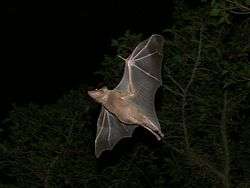Egyptian fruit bat
| Egyptian fruit bat | |
|---|---|
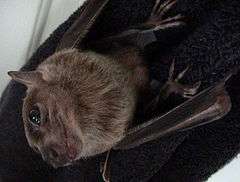 | |
| Scientific classification | |
| Kingdom: | Animalia |
| Phylum: | Chordata |
| Class: | Mammalia |
| Order: | Chiroptera |
| Family: | Pteropodidae |
| Subfamily: | Pteropodinae |
| Genus: | Rousettus |
| Species: | R. aegyptiacus |
| Binomial name | |
| Rousettus aegyptiacus (Geoffroy, 1810) | |
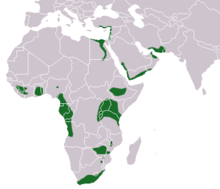 | |
| Egyptian rousette range | |
| Synonyms[2] | |
| |
The Egyptian fruit bat or Egyptian rousette (Rousettus aegyptiacus) is a species of Old World fruit bat.
Name
Étienne Geoffroy Saint-Hilaire originally gave this species the specific name of egyptiacus in 1810,[3] but he later revised it to ægyptiacus.[4] In 1992, G. B. Corbet and J. E. Hill argued that this revision was invalid and changed the name back to egyptiacus;[5] the 1999 Mammalian Species review used egyptiacus as well.[6] However, Geoffroy's revision was argued to be valid in 2001 by D. Kock.[7] He notes that the second spelling was "accepted almost universally by the scientific community", including by the first reviser, Knud Andersen,[7] who used ægyptiacus and wrote that egyptiacus "may [...] be considered a slip or misprint corrected by the author himself".[8] Even if it was an unjustified emendation at first, it became a justified emendation through widespread use according to the ICZN Code since the use of aegyptiacus was undisputed until Corbet & Hill.[7] Kock also writes that since the Latin adjective for "Egyptian" is aegyptiacus, egyptiacus is a simple misspelling in the original description.[7] Books like Mammal Species of the World and Mammals of Africa follow Kock and use the name aegyptiacus.[2][9] The Agreement on the Conservation of Populations of European Bats was amended to use the specific name aegyptiacus in 2003.[10][11]
Subspecies
There are six subspecies.[12][6]
- R. a. aegyptiacus (Geoffroy, 1810)
- R. a. leachii (Smith, 1829)
- R. a. unicolor (Gray, 1870)
- R. a. arabicus Anderson & de Winton, 1902
- R. a. princeps Juste & Ibañez, 1993
- R. a. tomensis Juste & Ibañez, 1993
The subspecies R. a. princeps and R. a. tomensis were discovered on the islands of Príncipe and São Tomé, respectively.[13]
Distribution
Egyptian fruit bats are found throughout Africa, except in the desert regions of the Sahara, and throughout the Middle East, as far east as Pakistan and northern India. Due to its extensive geographic range, and relatively large wild population, Rousettus aegyptiacus does not hold any specific conservation status.
Description
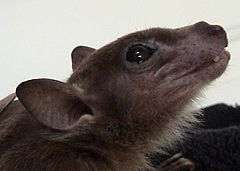
The Egyptian fruit bat is small compared to some of its megachiropterid relatives. Its wingspan averages 60 cm (2 ft), and body length around 15 cm (6 in). Its weight is typically around 160 g (5.6 oz). Males are larger than the females and can be easily distinguished by their large scrotum. This bat is typically light brown in color, with darker brown wings. It has large, pointed ears, dark eyes, and a long dog-like muzzle - which sometimes leads it to be referred to as a flying fox. Its fur is very soft, and the wings feel like pantyhose.
Behaviour
Like many bats, Egyptian fruit bats are nocturnal. They spend their days roosting in trees or caves, often with large groups of other bats, sometimes numbering in the thousands. They emerge from the roost to forage for food in the late evening, and return just before dawn. They hang upside down, with their wings folded closely around their bodies. Egyptian fruit bats, along with other species in the genus Rousettus, are the only megachiropterid bats to use echolocation, which they accomplish by emitting a series of sharp clicks with their tongues. The clicks are normally slow and constant, and speed up dramatically when the bats approach an object. They also make use of a range of vocalizations for communication, including grunts and screeches. As a result, a large roosting colony can be a deafening cacophony.
Diet
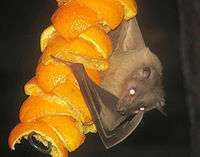
Egyptian fruit bats are frugivorous, consuming large amounts of fruit each night. Wild dates tend to be a favorite, but they consume almost any soft, pulpy fruit. Most of their diets tends to consist of unripe fruit and insect- and fungus-damaged fruit, which allows them to thrive in habitats where ripe fruit are not available year-round.
Reproduction
Maturity is reached at about nine months of age. Females typically give birth to only a single baby each year, but twins are occasionally born, after a gestation period around 115–120 days. The young are carried by the female until they are able to hang from the roost on their own (after about six weeks), then they are left in the roost while the mother forages for food. Once the baby bat can fly, at about three months of age, it will leave the roost on its own to hunt for its own food. Offspring typically stay with the same colony as the parents for their entire lives.
In captivity
The Egyptian fruit bat is well represented in zoos around the world. They breed readily in captivity and easily adapt to a captive diet of more commonly available fruits and nectar. They are popular as pets, because of their 'handsome' appearance, although they generally do poorly, as most pet owners have not had professional training and do not know how to care for them, and usually die with a year.[14]
Concerns
These bats, as well as many other fruit-eating bats, are ecologically important because they are pollinators or seed dispersers for many species of trees and plants. The baobab tree, for instance, relies almost exclusively on fruit bats to pollinate its flowers. Unfortunately, fruit bats also eat fruit crops intended for human consumption, so are consequently poisoned or otherwise eliminated by farmers to prevent loss of crops.
The Marburg and Ravn viruses, which are related to Ebola virus, are carried by apparently-healthy Egyptian fruit bats in Africa.[15]
References
- ↑ Mickleburgh; et al. (2004). "Rousettus aegyptiacus". IUCN Red List of Threatened Species. Version 2006. International Union for Conservation of Nature. Retrieved 11 May 2006.
- 1 2 Simmons, Nancy B. (2005). "Chiroptera: Pteropodidae". In Wilson, Don E.; Reeder, DeeAnn M. Mammal Species of the World: A Taxonomic and Geographic Reference (Third ed.). Baltimore: Johns Hopkins University Press. p. 347.
- ↑ Geoffroy-Saint-Hilaire (1810). "Description des rousettes et des céphalotes, Deux nouveaux genres de la famille des Chauvesouris". Annales du Muséum national d'histoire naturelle. Paris. 15: 96.
- ↑ Geoffroy-Saint-Hilaire (1813). "Description des mammifères qui se trouvent en Égypte". Description de l'Égypte. Paris. p. 134.
- ↑ Corbet, G. B.; Hill, J. E. (1992). The Mammals of the Indomalayan Region: A Systematic Review. Oxford: Oxford University Press. Cited in Simmons (2005) and Happold (2013).
- 1 2 Kwiecinski, Gary G.; Griffiths, Thomas A. (1999). "Rousettus egyptiacus". Mammalian Species (611): 1–9. doi:10.2307/3504411. JSTOR 3504411.
- 1 2 3 4 Kock, Dieter (2001). "Rousettus aegyptiacus (E. Geoffroy St. Hilaire, 1810) and Pipistrellus anchietae (Seabra, 1900), justified emendations of original spellings". Acta Chiropterologica. 3: 245–256. .
- ↑ Andersen, Knud (1912). "Rosettus ægyptiacus, E. Geoff". Megachiroptera. Catalogue of the Chiroptera in Collection of the British Museum. 1 (2nd ed.). London: Taylor and Francis.
- ↑ Happold, Meredith (2013). "Rousettus aegyptiacus Egyptian Rousette". In Happold, Meredith; Happold, David D. Hedgehogs, Shrews and Bats. Mammals of Africa. IV. London: Bloomsbury Publishing. p. 289. ISBN 9781408189962.
- ↑ Hutson, A. M. (22–24 September 2003). Review of Species to be listed on the Annex to the Agreement (PDF). 4th Session of the Meeting of Parties. Sofia. pp. 1–2.
- ↑ Resolution No. 4.8: Amendment of the Annex to the Agreement (PDF). 4th Session of the Meeting of Parties. Sofia. 22–24 September 2003. p. 53.
- ↑ Bergmans, Wim (1994). "Taxonomy and biogeography of African fruit bats (Mammalia, Megachiroptera). 4. The genus Rousettus Gray, 1821". Beaufortia. 44 (4): 79–126. ISSN 0067-4745.
- ↑ Juste, J.; Ibañez, C. (1993). "Geographic variation and taxonomy of Rousettus aegyptiacus (Mammalia: Megachiroptera) in the islands of the Gulf of Guinea". Zoological Journal of the Linnean Society. 107 (2): 117–129. doi:10.1111/j.1096-3642.1993.tb00217.x.
- ↑ Bat World Sanctuary: Bats As Pets https://batworld.org/pet-bats/
- ↑ Towner, Jonathan S.; Amman, Brian R.; Sealy, Tara K.; Carroll, Serena A. Reeder; Comer, James A.; Kemp, Alan; Swanepoel, Robert; Paddock, Christopher D.; Balinandi, Stephen; Khristova, Marina L.; Formenty, Pierre B. H.; Albarino, Cesar G.; Miller, David M.; Reed, Zachary D.; Kayiwa, John T.; Mills, James N.; Cannon, Deborah L.; Greer, Patricia W.; Byaruhanga, Emmanuel; Farnon, Eileen C.; Atimnedi, Patrick; Okware, Samuel; Katongole-Mbidde, Edward; Downing, Robert; Tappero, Jordan W.; Zaki, Sherif R.; Ksiazek, Thomas G.; Nichol, Stuart T.; Rollin, Pierre E.; Fouchier, Ron A. M. (31 July 2009). "Isolation of Genetically Diverse Marburg Viruses from Egyptian Fruit Bats". PLoS Pathogens. 5 (7): e1000536. doi:10.1371/journal.ppat.1000536. PMC 2713404. PMID 19649327.
Further reading
- Eisentraut, M. (1959). "Der Rassenkreis Rousettus aegyptiacus E. Geoff". Bonner zoologische Beiträge. 10 (3/4): 218–235.
- Gray, J. E. (1870). "Eleutherura ægyptiaca". Catalogue of Monkeys, Lemurs, and Fruit-eating Bats in the Collection of the British Museum. London. p. 117.
- Taylor (2005). "Rousettus aegyptiacus (E. Geoffroy Saint-Hilaire, 1810) Egyptian rousette". In Skinner, J. D.; Chimimba, Christian T. The Mammals of the Southern African Sub-region (3rd ed.). Cambridge University Press. pp. 267–269. doi:10.1017/CBO9781107340992.018.
External links
| Wikimedia Commons has media related to Egyptian fruit bat. |
![]()

